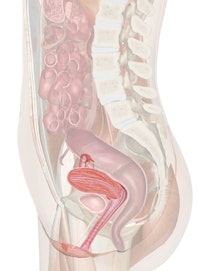Female Reproductive Organs of the Lower Torso (Cross-section View)

The female reproductive system of the lower abdomen and pelvis contains all of the organs necessary for the fertilization of egg cells, development of an embryo and fetus during pregnancy, and delivery of a newborn baby.
The external female reproductive organs are known collectively as the vulva. Within the vulva are several folds of skin surrounding the urinary and reproductive orifices known as the labia majora and labia minora. These folds of skin cover and protect the clitoris, urethral opening, and vaginal opening. Within the labia minora and superior to the urethra is the clitoris, a sensitive erectile organ that is responsible for producing feelings of sexual arousal and pleasure.
The internal female reproductive organs work together as a conduit for sperm to reach the egg cell during sexual intercourse and for the development and birth of the fetus during pregnancy. A muscular, epithelium lined tube known as the vagina connects the vulva to the cervix of the uterus. The uterus, or womb, is a muscular, pear-shaped, organ found between the vagina and the fallopian tubes. During pregnancy the fetus grows and develops within the protective uterus. Powerful muscle contractions of the uterus are responsible for delivering the fetus during childbirth. The narrow fallopian tubes extend from the left and right sides of the top of the uterus towards the ovaries. Following ovulation, the egg cell travels through the fallopian tubes to reach the uterus. The fallopian tubes also act as the location for fertilization of the egg cell if sperm are present following sexual intercourse. Resting at the end of each fallopian tube is an ovary. The ovaries are small, almond-sized glands that produce ova, commonly called egg cells, as well as the female sex hormones estrogen and progesterone.













